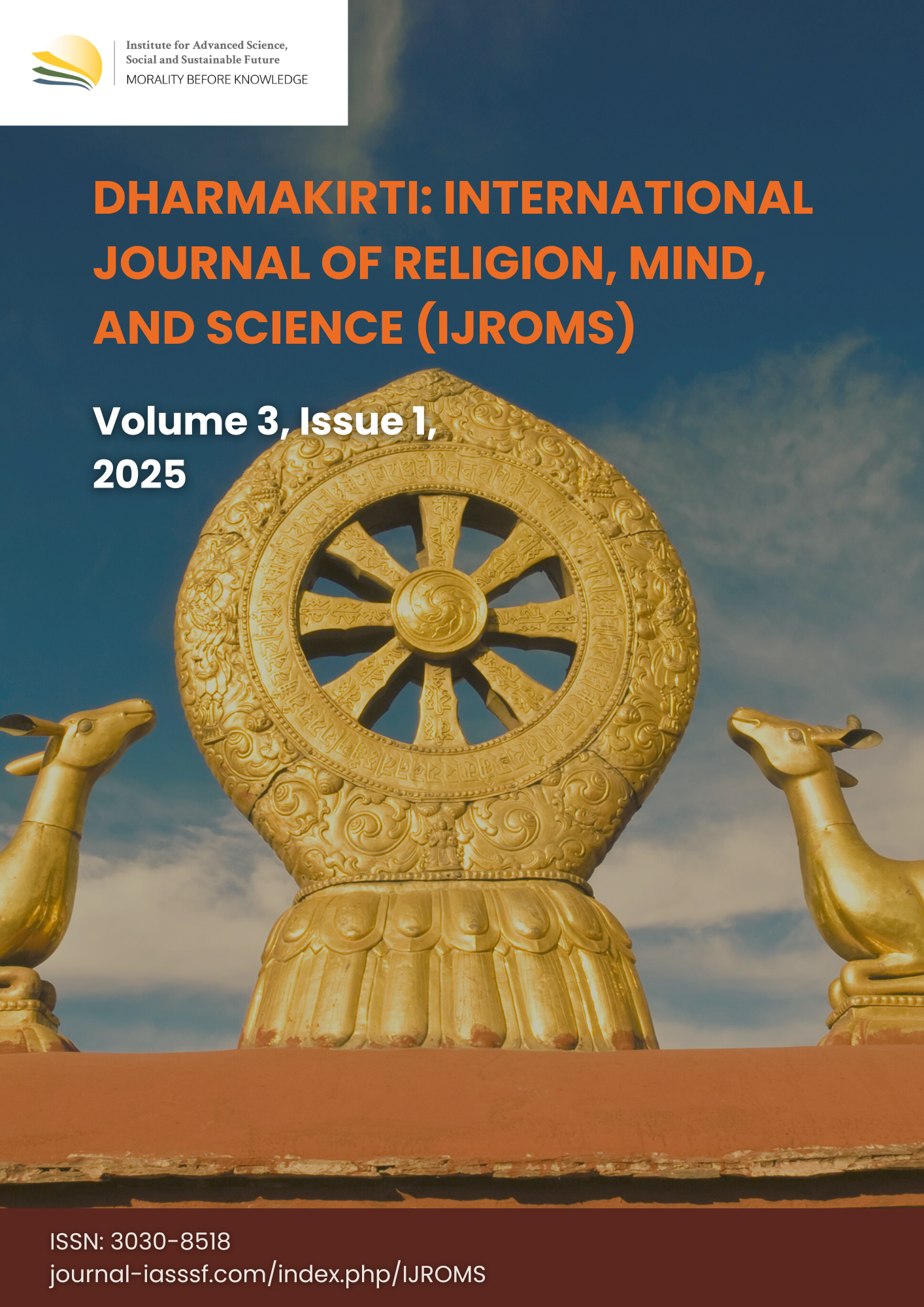Embodying the divine in Bali gender, ritual authority, and the politics of representation in Hindu
DOI:
https://doi.org/10.61511/ijroms.v3i1.2025.2306Keywords:
divine, gender, ritual authority, Hindu, BaliAbstract
Background: This article examines how women's bodies serve as a medium for divine power, or Śakti (transcendent feminine power), in Balinese Hindu rituals, to explain the articulation of religious authority and gender representation within patriarchal customary structures. Conceptually, this study draws on literature concerning ritual embodiment, religion as material practice, and community-based gender activism, which shows that religious authority arises from the performativity of sanctity embedded in social relations. Methods: The methods used include religious ethnography with participant observation, semi-structured interviews, and the documentation of rituals performed by female leaders such as Jero Mangku Istri and Jero Balian, as well as an in-depth case study of a female priest who her community has recognized since childhood as a medium for the goddess Danu. Finding: Women are not merely ritual performers but key actors who materialize and mediate the divine through movement, voice, and spiritual service; their authority is often not formally institutionalized but gains spiritual and symbolic legitimacy through communal recognition. These results align with the framework of ritual and material religion: transcendent experiences, the performativity of sanctity, and social networks work together to shape women's religious authority despite structural male domination. Conclusion: In conclusion, women's bodies become a field of negotiation between the sacred and the profane as well as a source of effective religious authority at the practical level. Novelty/Originality of this article: The novelty of this research lies in its empirical demonstration of how women's bodies as mediums of Śakti generate community-recognized authority despite not being formalized, as well as in its integration of religious ethnography with the framework of materialization and religion to map the dynamics of gender and power in contemporary Balinese Hinduism.
References
Burley, M. (2021). The nature and significance of the Hindu divine mother in embodied thealogical perspective. Religious Studies: An International Journal for the Philosophy of Religion, 57(4), 585–599. https://doi.org/10.1017/S0034412521000263
Bordeaux, J. (2024). From Bauddha Deśa to Śākta Pīṭha: Re/locating the Hindu goddess Tārā. Journal of Hindu Studies, 17(1), 1–20. https://doi.org/10.1093/jhs/hiac013
Connelly, W. L. (2021). Ritual and thought: Spirituality and method in philosophy of religion. Religions, 12(12), 1045. https://doi.org/10.3390/rel12121045
Crabtree, S. (2023). The mother, the warrior, the midwife and the holy whore: An ethnographic study of women’s faith, sacralisation and embodiment. Feminist Theology, 31(3), 317–333. https://doi.org/10.1177/09667350231183073
Craddock, E. (2024). Divine power and fluid bodies: Tirunaṅkais in Tamil Nadu. International Journal of Hindu Studies, 28(2), 259–281. https://doi.org/10.1007/s11407-024-09362-9
David, C. (2023). Shakti and Lakshmi principles: Empowering women in Indian tradition. Synergy, 19(1), 43–52. https://doi.org/10.24818/syn/2023/19/1.04
Deb Roy, S. (2022). Superheroines, their costumes and patriarchal representations: A case study of three Indian comic book ‘superheroines’. Journal of Graphic Novels and Comics, 13(6), 1209–1227. https://doi.org/10.1080/21504857.2022.2025877
DeNapoli, A. E. (2023). Everyone drinks from the same well: Charismatic female gurus as religious feminist influencers in South Asian Hinduism. Religions, 14(2), 1–18. https://doi.org/10.3390/rel14020153
DeNapoli, A. E. (2023). Can a woman be a true guru? Female Hindu gurus’ grassroots religious gender activism in India, and the performativity of saintliness at the Kumbh Mela. Feminist Encounters: A Journal of Critical Studies in Culture and Politics, 7(1), 1–15. https://doi.org/10.20897/femenc/12823
DeNapoli, A. E. (2023). Embodying saintliness: Gender, charisma, and the politics of representation in Indian religions. Routledge.
Della Costa, F. (2022). Ritual as metaphor. Anthropological Theory, 22(4), 515–534. https://doi.org/10.1177/14634996221130834
Gairola, V. (2023). Review of Shaligram pilgrimage in the Nepal Himalayas by Holly Walters. Himalaya, 43(1), 175–177. https://doi.org/10.2218/himalaya.2023.8045
Ghafournia, N. (2022). Muslim women’s religious leadership: The case of Australian mosques. Religions, 13(2), 171. https://doi.org/10.3390/rel13020171
Houlbrook, C. (2020). Religion and material culture: Studying religion and religious elements on the basis of objects, architecture, and space. Time & Mind, 13(1), 3–16. https://doi.org/10.1080/1751696x.2020.1721181
Harrison, V. S., & Gayle, R. (2020). Self-transformation and spiritual exemplars. European Journal for Philosophy of Religion, 12(4), 133–155. https://doi.org/10.24204/EJPR.V12I4.3520
Karasiński, M. (2021). Śākta Tantric traditions of Kerala in the process of change. Religions of South Asia, 15(3), 251–276. https://doi.org/10.1558/ROSA.19322
Kerekes, S. (2020). Material religion [Review of the book Material religion, edited by D. Apostolos‐Cappadona]. Religious Studies Review, 46(3), 366–367. https://doi.org/10.1111/rsr.14358
Lange, G. (2023). Divine Śakti and human power relations: Studying the embodied and enacted feelings of a Himalayan Hindu goddess. Material Religion, 19(5), 536–556. https://doi.org/10.1080/17432200.2023.2170112
Lucia, A. (2020). Charisma in Hinduism. In M. Lindhardt (Ed.), Studying charisma (pp. 139–161). Palgrave Macmillan. https://doi.org/10.1007/978-3-030-39601-8_6
McDaniel, J. (2023). Shakti in village India: Priestesses, Sadhikas, Bhar Ladies, Ayes, Bhaktas, Witches, and Bonga Girls. Religions, 14(6), 789. https://doi.org/10.3390/rel14060789
Menon, U. (2002). Making Śakti: Controlling (natural) impurity for female (cultural) power. In M. Rajan & J. G. Roche (Eds.), Communal identity in India: Its construction and articulation in the twentieth century (pp. 101–117). Oxford University Press.
Mukherjee, A., Lama, M., Khakurel, U., Jha, A., Ajose, F., Acharya, S., Tymes-Wilbekin, K., Sommer, M., Jolly, P., Lhaki, P., & Shrestha, S. (2020). Perception and practices of menstruation restrictions among urban adolescent girls and women in Nepal: A cross-sectional survey. Reproductive Health, 17, 159. https://doi.org/10.1186/s12978-020-00935-6
Ohaja, M., & Anyim, C. (2021). Rituals and embodied cultural practices at the beginning of life: African perspectives. Religions, 12(11), 1024. https://doi.org/10.3390/rel12111024
Padhi, S. (2024). The divine feminine in Hinduism: Goddesses & empowerment. Educational Administration: Theory and Practice, 30(2), 58–66. https://doi.org/10.53555/kuey.v30i2.7510
Patel, T., Angne Alfaro, S. M., & Swaranjali, P. (2020). The bodily and the divine: Study of a 10th century Hindu temple in Rajasthan, India. Journal of Interior Design, 45(4), 5–21. https://doi.org/10.1111/joid.12185
Perkins, S. (2022). Embodying Devī: Śākta narratives of healing and transformation. Religions, 13(12), 1149. https://doi.org/10.3390/rel13121149
Puett, M. J. (2020). Ritual as theory, theory as ritual. HAU: Journal of Ethnographic Theory, 10(3), 18–25. https://doi.org/10.1086/711711
Saxena, N. B. (2021). Women, goddesses and tantric praxis: A liberatory antidote to ‘Hindutva’ nationalist politics. South Asian History and Culture, 12(2–3), 151–166. https://doi.org/10.1080/09584935.2021.1915246
Strudwick, L. (2022). Review: The thing about religion: An introduction to the material study of religions, by David Morgan. Nova Religio, 26(2), 93–95. https://doi.org/10.1525/nr.2022.26.2.93
Shtyrkov, S. (2022). “Material religion” as a method in social anthropology and the problem of the researcher’s access to “real” religious experience (Conclusion). Antropologicheskij Forum, 18(55), 153–164. https://doi.org/10.31250/1815-8870-2022-18-55-153-164
Vemuri, A., & Krishnamurti, S. (2022). “Bring about the change we want to see”: Ram Devineni and the media spectacle of Priya’s Shakti. Feminist Media Studies, 22(8), 2117–2133. https://doi.org/10.1080/14680777.2022.2108480
Williams, J. (2023). Embodied world construction: A phenomenology of ritual. Religious Studies: An International Journal for the Philosophy of Religion, 59(3), 307–324. https://doi.org/10.1017/S0034412523000033
Winfield, T. P. (2021). Embodied theodicy: From conceptual to bodily engagements with suffering. Journal of the American Academy of Religion, 89(1), 204–227. https://doi.org/10.1093/JAAREL/LFAA070
Downloads
Published
How to Cite
Issue
Section
Citation Check
License
Copyright (c) 2025 Ni Wayan Jemiwi Jero, Gautam Kumar Jha, Miki Kashiwa, Sanghati Paul

This work is licensed under a Creative Commons Attribution 4.0 International License.















